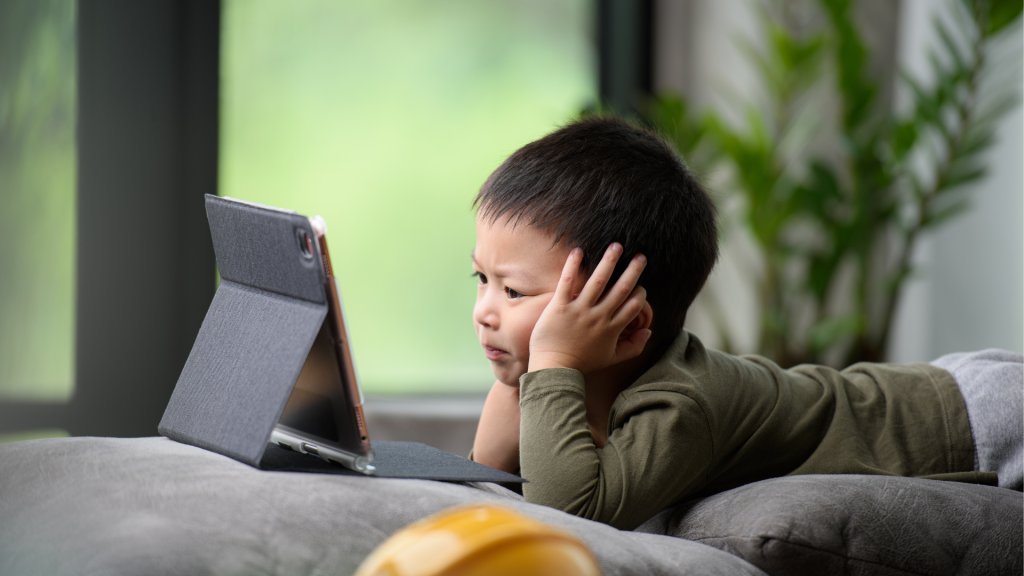Understanding Screen Time and Its Effects
Understanding screen time and its effects on children is important today. Screen time is the amount of time children spend on devices like phones, tablets, TVs, or computers. While technology can be helpful for learning and fun, too much use can cause problems.
Excessive screen time can harm a child’s health by reducing physical activity. This may lead to issues like obesity or eye strain. It can also affect sleep, especially if screens are used before bedtime. Mentally, too much screen use may lead to stress, mood swings, or trouble paying attention.
Children who use screens a lot may miss real-life interactions that help them grow. Talking, playing, and spending time with others builds language and social skills. It’s important to guide children toward useful, age-appropriate content and encourage other activities like playing outside, reading, or spending time with family.
The Impact of Screen Time on Mental Health
1. Cognitive and Emotional Development
Excessive screen time, particularly in young children, can negatively impact cognitive and emotional development. In response to these concerns, French medical experts have called for a complete ban on screen exposure for children under six, highlighting risks such as language delays, attention deficits, memory problems, and social difficulties. Likewise, the American Academy of Pediatrics recommends avoiding screen time for children under 18 months, with the exception of video chatting, and suggests only limited, high-quality programming for children between the ages of 2 and 5.
2. Behavioral and Developmental Issues
Research has shown a link between excessive screen time and increased behavioral issues in children. Studies suggest that children aged 6–17 who spend more than two hours per day on screens face a higher risk of behavioral and conduct problems, developmental delays, speech disorders, learning disabilities, and Attention Deficit Hyperactivity Disorder (ADHD).

Another study revealed that children aged 10-11 who spend extended hours on screens may experience overconfidence, reduced sleep, and impulsivity—symptoms associated with manic behavior.
3. Mental Health Concerns
Excessive screen time raises anxiety, depression, and emotional instability risks in young people. A UCSF study showed 9-10-year-olds with more screen exposure develop more mental health symptoms. Recent research also indicates that reducing screen time and increasing physical activity in childhood may protect adolescent mental health.
The Importance of Balanced Screen Time for Children
While screens can offer educational benefits, excessive use harms development. Balanced screen time helps prevent issues like attention deficits, sleep problems, and emotional difficulties. Encouraging outdoor play, social interaction, and offline activities supports healthy growth. Parents should set reasonable limits, prioritize quality content, and model balanced tech habits. A mindful approach ensures children benefit from technology without compromising their well-being.
Guidelines for Healthy Screen Time
While completely eliminating screen time may not be practical in today’s digital world, setting clear boundaries is crucial for healthy development. Here are research-backed recommendations with flexible implementation:
Under 18 Months: Pediatric experts strongly recommend avoiding screens entirely, with one important exception—video chatting with family members. This helps infants develop social connections while minimizing potential harm.
Ages 2–5: At this critical developmental stage, limit screen use to one hour per day of high-quality, educational content. More importantly, parents should actively participate by co-viewing and discussing what children watch.
Ages 6 and Up: As children grow older, focus shifts to maintaining balance. Establish consistent limits that prioritize:

- Sufficient sleep (screens off at least 1 hour before bedtime)
- Daily physical activity
- Face-to-face social interactions
The American Academy of Pediatrics stresses that these guidelines should be adapted to each child’s needs and family dynamics. The key considerations are always content quality, parental engagement, and ensuring screens don’t displace essential childhood experiences.
Remember, technology itself isn’t harmful—it’s how we use it that matters most. By being mindful and proactive, parents can help children develop healthy digital habits that last a lifetime.
Strategies for Parents and Caregivers
1. Model Healthy Screen Habits
Children are highly influenced by the behavior of adults around them. By managing your own screen time and engaging in meaningful offline activities, you model the habits you wish to instill. An expert in digital humanities, recommends switching phones to grayscale mode to reduce the visual appeal of apps. She also suggests practicing “algorithmic resistance” by regularly reviewing and curating your social media feeds to avoid overstimulation and maintain healthier digital engagement.
2. Create Screen-Free Zones

Establish designated screen-free areas in your home—such as bedrooms, dining rooms, and family spaces—to foster face-to-face interaction, improve sleep quality, and strengthen family bonds. These zones help reinforce the idea that not all moments need to be mediated through a screen.
3. Encourage Alternative Activities
Offer children engaging alternatives to screens, such as reading, outdoor adventures, sports, or arts and crafts. Research involving 186 studies found that while high screen time is linked to negative outcomes like stress, anxiety, and poor self-regulation, increased “green time” (time spent in nature) correlates with better mental health, cognitive development, and academic performance.
4. Use Technology Mindfully
Leverage digital tools like screen time trackers, app usage limits, and parental controls to maintain a healthy balance. Establish clear rules—such as no screen use during meals or within an hour of bedtime—to reduce overstimulation and promote better rest. Consistent boundaries help children understand the importance of using technology with intention rather than impulse.
FAQS
Q1: Why is it important for parents to model good screen habits?
Ans:- Children tend to mimic the behavior of adults. When parents exhibit mindful screen use and prioritize offline activities, children are more likely to adopt those behaviors themselves.
Q2: What are some examples of effective screen-free zones at home?
Ans:- Bedrooms, dining rooms, and family lounges are ideal places to designate as screen-free zones. These areas support better sleep, stronger relationships, and more meaningful communication.
Q3: What kinds of non-screen activities help boost children’s mental health?
Ans:- Outdoor play, sports, creative hobbies (like drawing or music), and reading are all beneficial. These activities stimulate imagination, social skills, and emotional resilience.




